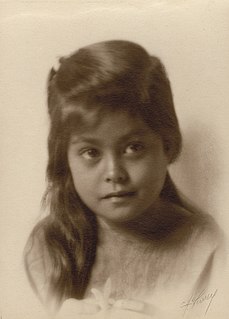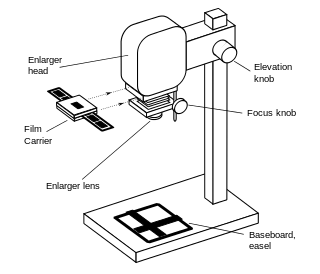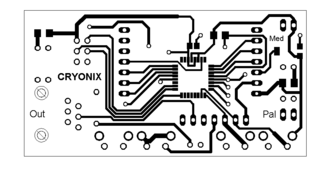Related Research Articles

A blueprint is a reproduction of a technical drawing or engineering drawing using a contact print process on light-sensitive sheets. Introduced by Sir John Herschel in 1842, the process allowed rapid and accurate production of an unlimited number of copies. It was widely used for over a century for the reproduction of specification drawings used in construction and industry. The blueprint process was characterized by white lines on a blue background, a negative of the original. The process was not able to reproduce color or shades of grey.

The collodion process is an early photographic process. The collodion process, mostly synonymous with the "collodion wet plate process", requires the photographic material to be coated, sensitized, exposed and developed within the span of about fifteen minutes, necessitating a portable darkroom for use in the field. Collodion is normally used in its wet form, but can also be used in dry form, at the cost of greatly increased exposure time. The latter made the dry form unsuitable for the usual portraiture work of most professional photographers of the 19th century. The use of the dry form was therefore mostly confined to landscape photography and other special applications where minutes-long exposure times were tolerable.

Photographic paper is a paper coated with a light-sensitive chemical formula, like photographic film, used for making photographic prints. When photographic paper is exposed to light, it captures a latent image that is then developed to form a visible image; with most papers the image density from exposure can be sufficient to not require further development, aside from fixing and clearing, though latent exposure is also usually present. The light-sensitive layer of the paper is called the emulsion. The most common chemistry was based on Silver halide but other alternatives have also been used.

Cyanotype is a photographic printing process that produces a cyan-blue print. Engineers used the process well into the 20th century as a simple and low-cost process to produce copies of drawings, referred to as blueprints. The process uses two chemicals: ferric ammonium citrate and potassium ferricyanide.

The albumen print, also called albumen silver print, was published in January 1847 by Louis Désiré Blanquart-Evrard, and was the first commercially exploitable method of producing a photographic print on a paper base from a negative. It used the albumen found in egg whites to bind the photographic chemicals to the paper and became the dominant form of photographic positives from 1855 to the start of the 20th century, with a peak in the 1860-90 period. During the mid-19th century, the carte de visite became one of the more popular uses of the albumen method. In the 19th century, E. & H. T. Anthony & Company were the largest makers and distributors of the Albumen photographic prints and paper in the United States.

The gelatin silver process is the most commonly used chemical process in black-and-white photography, and is the fundamental chemical process for modern analog color photography. As such, films and printing papers available for analog photography rarely rely on any other chemical process to record an image. A suspension of silver salts in gelatin is coated onto a support such as glass, flexible plastic or film, baryta paper, or resin-coated paper. These light-sensitive materials are stable under normal keeping conditions and are able to be exposed and processed even many years after their manufacture. This was an improvement on the collodion wet-plate process dominant from the 1850s–1880s, which had to be exposed and developed immediately after coating.

An enlarger is a specialized transparency projector used to produce photographic prints from film or glass negatives, or from transparencies.

A contact print is a photographic image produced from film; sometimes from a film negative, and sometimes from a film positive or paper negative. In a darkroom an exposed and developed piece of film or photographic paper is placed emulsion side down, in contact with a piece of photographic paper, light is briefly shone through the negative or paper and then the paper is developed to reveal the final print.
Photographic printing is the process of producing a final image on paper for viewing, using chemically sensitized paper. The paper is exposed to a photographic negative, a positive transparency , or a digital image file projected using an enlarger or digital exposure unit such as a LightJet or Minilab printer. Alternatively, the negative or transparency may be placed atop the paper and directly exposed, creating a contact print. Digital photographs are commonly printed on plain paper, for example by a color printer, but this is not considered "photographic printing".

Whiteprint describes a document reproduction produced by using the diazo chemical process. It is also known as the blue-line process since the result is blue lines on a white background. It is a contact printing process which accurately reproduces the original in size, but cannot reproduce continuous tones or colors. The light-sensitivity of the chemicals used was known in the 1890s and several related printing processes were patented at that time. Whiteprinting replaced the blueprint process for reproducing architectural and engineering drawings because the process was simpler and involved fewer toxic chemicals. A blue-line print is not permanent and will fade if exposed to light for weeks or months, but a drawing print that lasts only a few months is sufficient for many purposes.

Sun printing may refer to various printing techniques which use sunlight as a developing or fixative agent.

Gum bichromate is a 19th-century photographic printing process based on the light sensitivity of dichromates. It is capable of rendering painterly images from photographic negatives. Gum printing is traditionally a multi-layered printing process, but satisfactory results may be obtained from a single pass. Any color can be used for gum printing, so natural-color photographs are also possible by using this technique in layers.
Architectural reprography, the reprography of architectural drawings, covers a variety of technologies, media, and supports typically used to make multiple copies of original technical drawings and related records created by architects, landscape architects, engineers, surveyors, mapmakers and other professionals in building and engineering trades.

Photographic film is a strip or sheet of transparent film base coated on one side with a gelatin emulsion containing microscopically small light-sensitive silver halide crystals. The sizes and other characteristics of the crystals determine the sensitivity, contrast, and resolution of the film.
A heliographic copier or heliographic duplicator is an apparatus used in the world of reprography for making contact prints on paper from original drawings made with that purpose on tracing paper, parchment paper or any other transparent or translucent material using different procedures. In general terms some type of heliographic copier is used for making: Hectographic prints, Ferrogallic prints, Gel-lithographs or Silver halide prints. All of them, until a certain size, can be achieved using a contact printer with an appropriate lamp but for big engineering and architectural plans, the heliographic copiers used with the cyanotype and the diazotype technologies, are of the roller type, which makes them completely different from contact printers.

A photolith film is a transparent film, made with some sort of transparent plastic. Nowadays, with the use of laser printers and computers, the photolith film can be based on polyester, vegetable paper or laser film paper. It is mainly used in all photolithography processes.
The Kodak verifax, is a photo copying approach that uses a wet colloidal diffusion transfer technique patented by Yutzy, H.C. and Yackel, E.C. (1947) The light source is projected to the top crossing the negative being reflected -more or less, according to the color- against the original to be copied exposing the negative. Has a base that contains the recipient with the liquid developer and the exposure Timer.
A thermal copier or thermocopier is a kind of photocopier based on the effect of heat. The original sheet feeds in conjunction with the "thermo-sensitive" paper, generating a copy on its specially treated surface. The black parts on the original sheet, once scanned, make the copier activate the heating elements that produce some chemical reactions on the "thermo-sensitive" copy paper that darkens its surface. After the process, a stable black-and-white image is obtained on the cooled film or paper.

The oil print process is a photographic printmaking process that dates to the mid-19th century. Oil prints are made on paper on which a thick gelatin layer has been sensitized to light using dichromate salts. After the paper is exposed to light through a negative, the gelatin emulsion is treated in such a way that highly exposed areas take up an oil-based paint, forming the photographic image.

Cyanography is an artistic practice that utilises a particular type of photographic reproduction – the cyanotype. Invented in 1842 by Sir John Herschel, this process requires a material, commonly fabric or paper, to be coated in photosensitive solution – usually a combination of ferric ammonium citrate and potassium ferricyanide. This results in blue mono-tonal reproductions of the photographic negative, commonly called a blueprint.
References
- 1 2 Cryder, George R. (November 1948). "Contact". Popular Mechanics. Hearst Magazines. pp. 216–. ISSN 0032-4558.
- ↑ Eva Zeisel; Robert Sabella (2006). Blueprints replaced by whiteprints. Que Certification. pp. 244–. ISBN 978-0-7897-3504-1.
- ↑ NIIR board (1 October 2002). Hand Book on Printing Technology (offset, Gravure, Flexo, Screen). National Institute Of Industrial Research. pp. 222–. ISBN 978-81-7833-087-7.